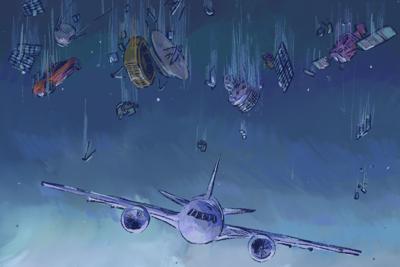In November 2022, a massive rocket booster fell from the sky. About 30 metres long and weighing as much as 23 tonnes, the booster ŌĆö part of ChinaŌĆÖs efforts to build its Tiangong space station ŌĆö had orbited Earth for four days. Eventually, the drag of the atmosphere won out. And the rocket fell.
It was ŌĆ£one of the largest pieces of debris re-entering in the near past,ŌĆØ EU Space Surveillance and Tracking said at the time. Spain closed part of its airspace along the predicted trajectory for the better part of an hour; 300 flights were delayed.
In the end, the rocket, torn to pieces in its violent tumble through the atmosphere, came down over the Pacific Ocean. But these types of airspace closures and flight delays are only growing ŌĆö as is the risk, eventually, of a catastrophic collision with a plane, a by University of British Columbia researchers has found.
ThereŌĆÖs a 26 per cent chance every year that a leftover rocket will come down in a busy airspace somewhere in the world, the researchers found, a probability that will increase as the rate of rocket launches grows each year.
The risk is so great that by 2035, one previous estimate showed, there will be a one-in-119 chance every year of someone dying from space debris.
ŌĆ£The airspace closures right now, the junk that weŌĆÖre finding on the ground, thatŌĆÖs the warning,ŌĆØ said Aaron Boley, who co-authored the study and is co-director of the Outer Space Institute. ŌĆ£ItŌĆÖs telling us that unless we change our practices, that low-probability, high-consequence event can indeed happen.ŌĆØ
These events, the paper says, carry not just safety risks but economic ones, too. Airspace closures and delayed flights mean increased staffing and scheduling costs shouldered by the airlines and time costs borne by passengers. Previous estimates for these closures have put the cost in the tens of millions of dollars.
It presents an impossible dilemma for authorities, the authors said. Do you keep airspace open and run the risk of an unprecedented disaster? Or do you close airspace and incur millions in cost overruns?
ŌĆ£This is ultimately being imposed on the aviation industry by a different industry,ŌĆØ Boley said. ŌĆ£Why does the aviation industry even need to be making these calls? Because of the actions of (the space industry).ŌĆØ
More rockets means more risk
The paper looked only at the risk from leftover rocket bodies in orbit, of which there are over 2,300 that will eventually re-enter Earth ŌĆö some within months, others in centuries. There are plenty of discarded satellites in orbit, too, but rocket bodies pose a greater risk because of their size and the unlikelihood they will burn up on re-entry.
ItŌĆÖs next to impossible to predict where these rockets will re-enter, Boley said, because they are travelling at close to eight kilometres a second and miscalculating the entry time by even just one minute results in a dramatically different debris zone.
All it takes, the paper says, is a piece of debris 300 grams in size, whistling down from orbit at immense speeds, to result in the total loss of an aircraft. Debris as small as one gram could cause damage, particularly if it hits a windshield or engine.
In 2023, there were 212 successful launches ŌĆö 128 of which left rocket bodies in orbit for eventual uncontrolled re-entries, according to the authors. Large uncontrolled re-entries happen almost weekly.
And the space industry is growing. The 259 orbital launch attempts in 2024 broke the previous record, set only one year prior, and is expected to be broken again this year. Elon Musk, CEO of SpaceX, wants to launch the companyŌĆÖs new Starship rocket 25 times in 2025 and get to a hundred annual launches within a few years, a SpaceX official .
Meanwhile, Jeff BezosŌĆÖ Blue Origin successfully launched its mega New Glenn rocket for the first time last month, adding another vehicle to the burgeoning commercial space sector.
At the same time, closer to the ground, the skies are getting busier, according to the UBC researchers. The number of daily flights has almost doubled in the last 25 years and passengers have increased by more than 250 per cent.
The probability of a fatal aircraft collision with space debris is predicted to rise to seven in 10,000 per year by 2035, according to a 2021 analysis by the U.S.-based non-profit Aerospace Corporation.
Regulation is needed, researcher says
The problem, according to University of Regina astronomy professor Samantha Lawler, is that this system of leaving leftover rockets in space was established during the Apollo era, when only a handful of countries were doing so, and at slow rates.
ŌĆ£ItŌĆÖs supposed to be small numbers ŌĆ” putting these big bus sized rocket bodies up into orbit ŌĆö like, ŌĆśOh it’s fine, theyŌĆÖll fall somewhere,ŌĆÖŌĆØ said Lawler, who researches space debris. ŌĆ£Once you start having many, many re-entries, all of those small probabilities add up to something that is quite dangerous.ŌĆØ
Putting the extra fuel and tech on rockets to force them out of orbit on-command comes at an extra financial cost, Boley said, but it should be regulated and incentivized before the worst-case-scenario happens.
ŌĆ£We need,ŌĆØ Boley said, ŌĆ£to take care of the really big risks right away.ŌĆØ























To join the conversation set a first and last name in your user profile.
Sign in or register for free to join the Conversation